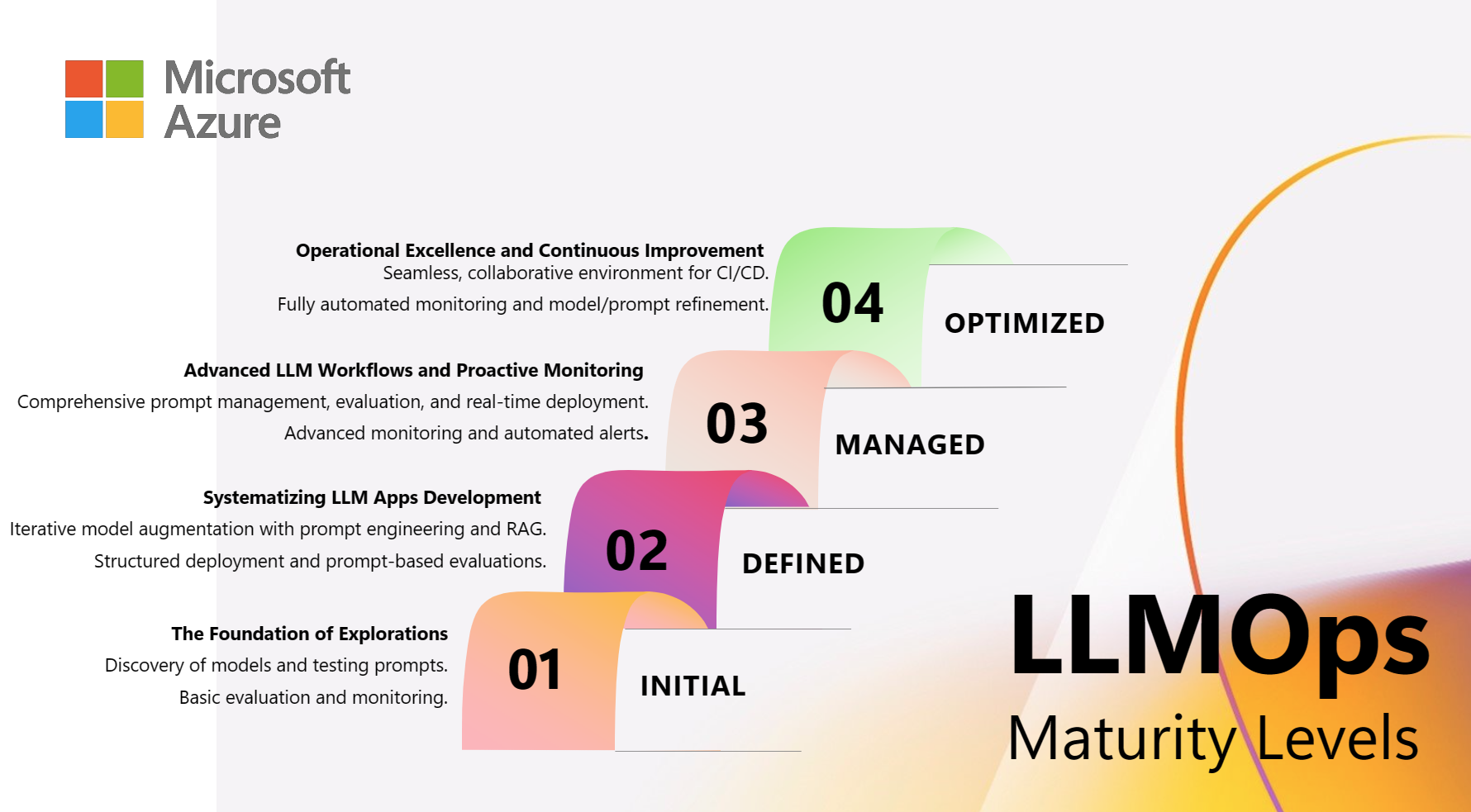Advance your maturity level for Large Language Model Operations (LLMOps)
Large Language Model Operations, or LLMOps, describes the operational practices and strategies for managing large language models (LLMs) in production. This article provides guidance on how to advance your capabilities in LLMOps, based on your organization's current maturity level.
Use the descriptions below to find your LLMOps Maturity Model ranking level. These levels provide a general understanding and practical application level of your organization. The guidelines provide you with helpful links to expand your LLMOps knowledge base.
Tip
Use the LLMOps Maturity Model Assessment to determine your organization's current LLMOps maturity level. The questionnaire is designed to help you understand your organization's current capabilities and identify areas for improvement.
Your results from the assessment corresponds to a LLMOps Maturity Model ranking level, providing a general understanding and practical application level of your organization. These guidelines provide you with helpful links to expand your LLMOps knowledge base.
Level 1 - initial
Tip
Score from LLMOps Maturity Model Assessment: initial (0-9).
Description: Your organization is at the initial foundational stage of LLMOps maturity. You're exploring the capabilities of LLMs but haven't yet developed structured practices or systematic approaches.
Begin by familiarizing yourself with different LLM APIs and their capabilities. Next, start experimenting with structured prompt design and basic prompt engineering. Review Microsoft Learning articles as a starting point. Taking what you’ve learned, discover how to introduce basic metrics for LLM application performance evaluation.
Suggested references for level 1 advancement
- Azure AI Studio Model Catalog
- Explore the Azure AI Studio Model Catalog
- Introduction to Prompt Engineering
- Prompt Engineering Techniques
- System Message Framework
- Prompt Flow in Azure AI Studio
- Evaluate GenAI Applications with Azure AI Studio
- GenAI Evaluation and Monitoring Metrics with Azure AI Studio
To better understand LLMOps, consider available MS Learning courses and workshops.
Level 2 - defined
Tip
Score from LLMOps Maturity Model Assessment: maturing (10-14).
Description: Your organization has started to systematize LLM operations, with a focus on structured development and experimentation. However, there's room for more sophisticated integration and optimization.
To improve your capabilities and skills, learn how to develop more complex prompts and begin integrating them effectively into applications. During this journey, you’ll want to implement a systematic approach for LLM application deployment, possibly exploring CI/CD integration. Once you understand the core, you can begin employing more advanced evaluation metrics like groundedness, relevance, and similarity. Ultimately, you’ll want to focus on content safety and ethical considerations in LLM usage.
Suggested references for level 2 advancement
- Take our step-by-step workshop to elevate your LLMOps practices
- Prompt Flow in Azure AI Studio
- How to Build with Prompt Flow
- Deploy a Flow as a Managed Online endpoint for Real-Time Inference
- Integrate Prompt Flow with LLMOps
- GenAI Evaluation with Azure AI Studio
- GenAI Evaluation and Monitoring Metrics
- Azure Content Safety
- Responsible AI Tools and Practices
Level 3 - managed
Tip
Score from LLMOps Maturity Model Assessment: maturing (15-19).
Description: Your organization is managing advanced LLM workflows with proactive monitoring and structured deployment strategies. You're close to achieving operational excellence.
To expand your base knowledge, focus on continuous improvement and innovation in your LLM applications. As you progress, you can enhance your monitoring strategies with predictive analytics and comprehensive content safety measures. Learn to optimize and fine-tune your LLM applications for specific requirements. Ultimately, you want to strengthen your asset management strategies through advanced version control and rollback capabilities.
Suggested references for level 3 advancement
- Fine-tuning with Azure ML Learning
- Model Customization with Fine-tuning
- GenAI Model Monitoring
- Elevate LLM Apps to Production with LLMOps
Level 4 - optimized
Tip
Score from LLMOps Maturity Model Assessment: optimized (20-28).
Description: Your organization demonstrates operational excellence in LLMOps. You have a sophisticated approach to LLM application development, deployment, and monitoring.
As LLMs evolve, you’ll want to maintain your cutting-edge position by staying updated with the latest LLM advancements. Continuously evaluate the alignment of your LLM strategies with evolving business objectives. Ensure that you foster a culture of innovation and continuous learning within your team. Last, but not least, share your knowledge and best practices with the wider community to establish thought leadership in the field.
Suggested references for advanced techniques
Feedback
Coming soon: Throughout 2024 we will be phasing out GitHub Issues as the feedback mechanism for content and replacing it with a new feedback system. For more information see: https://aka.ms/ContentUserFeedback.
Submit and view feedback for
